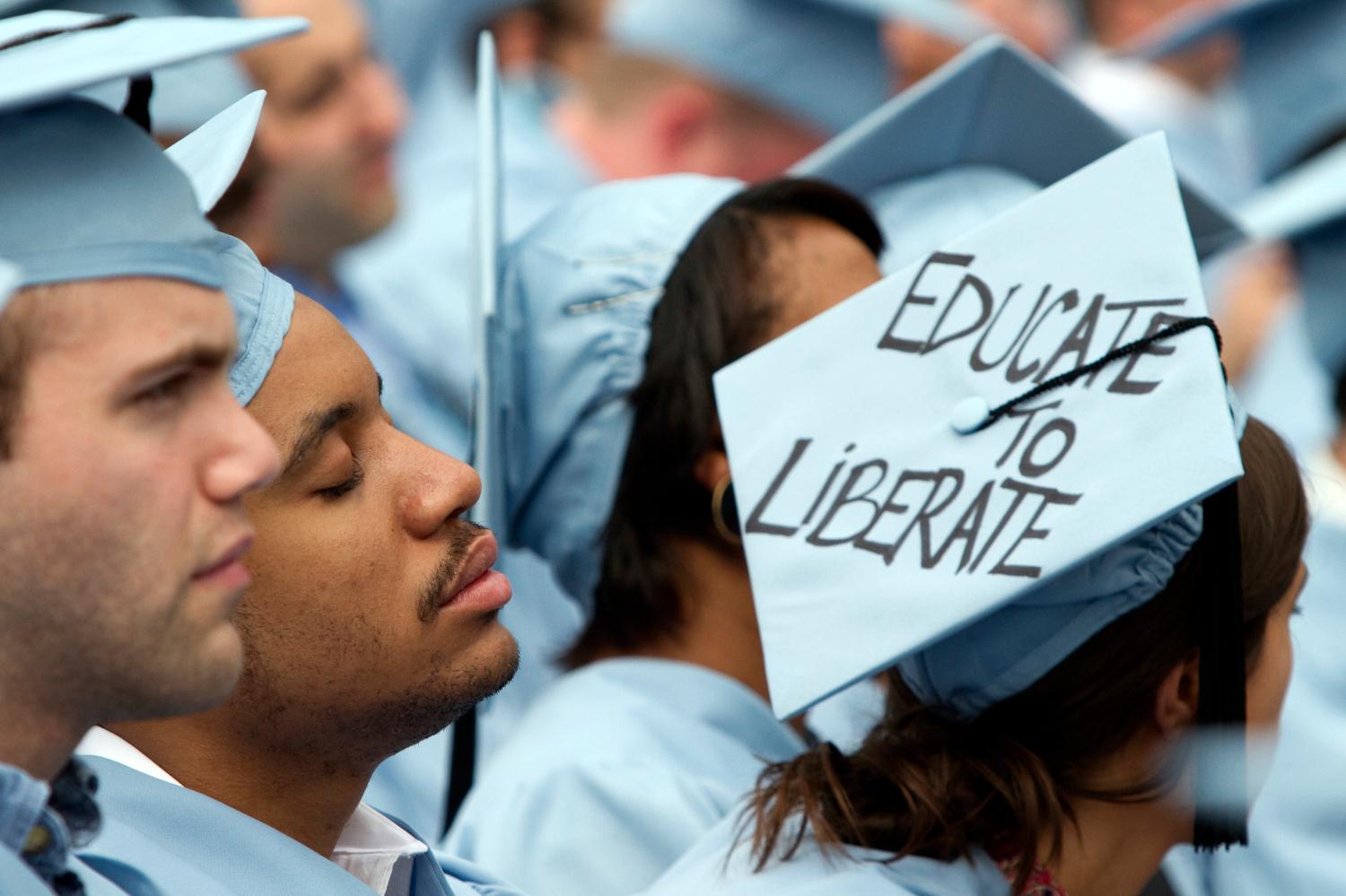Postsecondary education in the United States faces a conundrum: Can we preserve access, help students learn more and finish their degrees sooner and more often, and keep college affordable for families, all at the same time? And can the higher education reforms currently most in vogue—expanding the use of technology and making colleges more accountable—help us do these things?
Since the 1960s, colleges and universities have worked hard to increase access to higher education. Fifty years ago, with the industrial economy booming—as Sandy Baum, Charles Kurose, and Michael McPherson write in the latest issue of the Future of Children—only 45 percent of young people went to college when they graduated from high school. Today, they note, at least 70 percent enroll in some form of postsecondary education. Women, who once accounted for little more than a third of the college population, now outnumber men on campus, and minorities and the poor have also seen many barriers to a college education fall. Certainly, we still have work to do—for example, advantaged children are still much more likely than children living in poverty to go to college, and to attend elite institutions when they do. Yet the gains in access have been remarkable.
Over the past decade, critics have increasingly questioned the quality of college education in the U.S. In particular, they have pointed to low completion rates—only about half of the people who enroll at a postsecondary institution complete a degree or certificate within six years. Yes, there are many reasons that students attend such institutions, but even among those who report that they aspire to earn at least a bachelor’s degree, only about 36 percent do so.
Most recently, the loudest debates in higher education have been about cost. When people talk about the cost of postsecondary education, they usually mean tuition. The most alarming recent increases have been in the “sticker price,” or the published cost of attending an institution. Sticker prices for full-time in-state students at public four-year colleges and universities increased 27.2 percent between 2007 and 2012, according to the College Board. But only about one-third of full-time students pay the sticker price; the other two-thirds of full-time students pay the “net price,” which is the sticker price minus grants and other forms of aid. On average, the net price is 70 percent less than the sticker price. Even so, the net price of college has also increased steeply, by 18 percent over the same five years.
Many people take the sharp rise in tuition costs as evidence that institutions of higher education are inefficient and growing more so—in other words, that colleges and universities are spending more and more money to deliver the same education. They argue that if we aggressively adopt technology and strengthen accountability, we can make colleges and universities more efficient, whether that means providing the same education for less money, or a better education for the same cost.
But, in truth, tuition—whether we’re talking about sticker price or net price—doesn’t really tell us how much a college education costs. As McPherson, who is president of the Spencer Foundation, pointed out recently at a conference at Princeton, an institution’s total expenditure per student is a much better measure of the cost of a college education. Based on 2012 data from the College Board, expenditures per student, especially at public institutions, have been relatively flat over the past decade, increasing by about 6.4 percent at four-year public institutions and actually decreasing at two-year public institutions. Tuition itself accounts for only a part of the total expenditure per student. At public institutions in particular, the rest is made up largely by state subsidies. What has changed in recent years is that state subsidies have fallen precipitously, meaning that parents and students are shouldering more of the cost through rising tuition payments. From 2000 to 2010, the portion of total expenditures covered by tuition at public institutions went from just over one-third to just over one-half, with subsidies falling accordingly. If we look at the cost of college this way, it’s unlikely that growing inefficiency is the main problem facing institutions of higher education; in fact, they are educating more students than ever and doing so at roughly the same cost per student. Nonetheless, few people expect state subsidies to rebound to their former levels. If college is to remain affordable, state institutions must seek ways to lower their cost per student so that they can keep tuition in check.
What are the prospects, then, that technology and accountability can help us rein in the rate of growth in tuition? Unfortunately, the answer isn’t clear.
Technology
Policymakers like to focus on advances in technology as a solution for the tuition crisis because a major component underlying the cost of a postsecondary education is the cost of paying the faculty. As long as the wages that faculty members could earn in other parts of the economy continue to increase, there will be upward pressure on the cost of educating students. But if we could use advanced technology to let each faculty member teach more students, we could lower the cost of a college education. However, no one wants such an increase in productivity to reduce the quality of the education that students receive. Therefore, if technology is to help us solve higher education’s quandary, it must provide education at a lower cost without lowering its quality.
We have scant evidence of whether e-learning is comparable in quality to traditional classroom instruction. However, the best research so far suggests that in large lecture classes, at least, especially those that cover introductory material in some subjects, students learn just as well online as they do in “chalk and talk” classes. We know even less about the long-term cost of teaching in this way. On the one hand, once we pay the start-up and transition costs associated with adopting new technology and training faculty how to use it, the cost per student is likely to fall because faculty will be able to teach more students in larger classes. On the other hand, the best evidence about technology comes from its use in large lecture classes; we know much less about its effectiveness in smaller, typically more advanced courses, which are more expensive to teach by definition. We also have virtually no evidence about technology’s effectiveness in some disciplines, particularly the humanities. If technology can’t deliver the same education that students get in the classroom, what may look like a decrease in cost may actually be a decrease in quality. Thus before we know whether widespread adoption of technological tools is truly a promising approach to reducing the cost of a college education, we need more and better evidence about how these tools affect student learning, in which settings and for whom they work best, and how much they cost to implement and maintain.
Accountability
Policymakers are also talking about accountability as a way out of the postsecondary conundrum. Most public institutions receive state subsidies based on the number of students they enroll. Enrollment-based funding gives these colleges and universities a huge incentive to increase access, but far less incentive to boost completion rates and other measures of student success. On the heels of the movement to increase accountability in K-12 education, a lot of people, including President Obama, have been calling to make colleges and universities more accountable, most notably by tying some portion of state or federal funding to student completion or other measures of success—for example, how many graduates find jobs. Many states have already tried this, but the results have been disappointing (though it must be said, as Davis Jenkins and Olga Rodriguez write in the Future of Children, that much of the research on performance funding thus far has been qualitative rather than quantitative). One reason that performance funding hasn’t worked well may be that the percentage of aid that states have tied to performance has been quite low, meaning that institutions have had little to lose if they fail to meet performance targets. As a result, some reformers are calling for an even stronger connection between funding and accountability. Fair enough, and probably worth a try, but the bottom line is that we have yet to find solid evidence that tying appropriations to student success will produce the results we desire. And caution is in order: Unless such an approach is implemented and monitored carefully, it will create a perverse incentive for institutions to restrict admission to the students who are most likely to do well, thus potentially reversing the gains in access that we’ve worked so hard to achieve.
Conclusion
Despite the caveats I’ve presented here, I believe that both technology and accountability have their place in any effort to solve the postsecondary conundrum.
In the case of new technological tools to expand teaching productivity, we need to carefully study their effect on student learning, institutional stability, educational quality, and cost. It’s going to take some tinkering to build new models of technology-supported teaching that work as well as or better than a traditional classroom education, and we should not hesitate either to try promising approaches or to abandon those that fail to make the grade.
When it comes to imposing stronger accountability, we need comprehensive data systems and other ways to gather information that will give us a clearer, more scientifically sound picture of institutional performance than do the rough measures we use now, such as completion rates. Furthermore, measures of quality should never be the only criteria through which we reward or punish postsecondary institutions, not only because expanding access must remain a priority, but also because it is extremely unlikely that we will ever be able to capture all of postsecondary education’s beneficial outcomes through large-scale data.
In the end, however, technology and accountability alone will not solve the postsecondary conundrum. As tuition costs rise, parents and prospective students are starting to question the value of the postsecondary institutions they’re considering, seeking better information about quality and completion rates, and making decisions based on hard financial realities. This kind of pressure from prospective students and their families is likely to be the most effective incentive of all.



